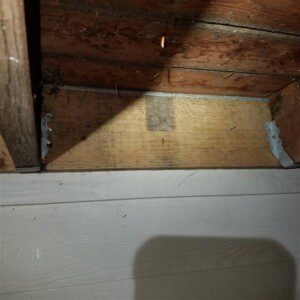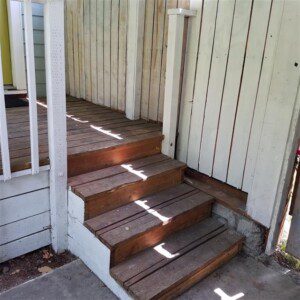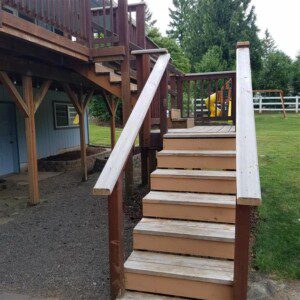Decks are attractive and useful features of homes, but even great-looking structures can have safety problems, and all of them need maintenance. As they extend the home footprint into the outdoors, they are vulnerable to increased weathering, and deterioration. They are commonly attached to exterior entrances, and may experience heavy traffic. Safe steps and rails should be provided. Ideal for outdoor entertaining, decks may be subject to heavy loading at times and guests unfamiliar with their limitations and hazards. Decks are often high enough above parts of the grade that falls can cause serious injury, so structural integrity and guards are critical. Having your deck inspected as part of a thorough home inspection is the key to catching a range of defects, and getting the most from your outdoor structures.
Ledgers
Unless they are designed as free-standing structures, decks should be securely attached to the house structure with a properly flashed ledger. A ledger is a horizontal board attached to the home that supports the deck framing. One of the most common attachment defects is a ledger attached to the home with nails or screws. Nails pull loose over time, which can cause the deck to detach from the home. Screws have less sideways or sheer strength than nails and overloading can cause them to break. Modern standards call for carriage bolts or lag screws into the house framing. These fasteners provide sheer strength and resist pulling out. They should be attached alternately near the top and bottom of the ledger, and spaced closer for longer joist spans.

Framing
Defects of the understructure, or framing that supports the deck, are often related to poor design. Decks are often built after initial home construction by persons unfamiliar with building standards, and may never have been inspected. Post bases in contact with the ground will rot over time. Over-spanned joists and excessive cantilever are common, and can lead to instability and even deck failure. Framing that holds up to regular use as an entrance and is safe for heavy loads during social gatherings often needs larger and more framing members than expected. Inadequate deck framing may look solid and substantial, so deficiencies may not be noticed until damage or injury results. Many home buyers will have no information on how a deck was planned, so any structural concerns identified should be taken seriously and acted on.
Walking Surface
The walking surface of decks is most vulnerable to deterioration and decay as it fully exposed to the sun and rain. Even firm-appearing planks may be rotted on the underside, which can weaken their attachment to the understructure. Unstable treads can be tripping hazards. Insufficient plank spacing can allow debris to accumulate, holding water and accelerating decay. Careful visual examination of both sides of the surface is important. Walking across the surface is a great way to detect weakness and insecure attachment.
Finish Coat
As outdoor structures exposed to the full range of year-round weathering, maintaining a resistant finish coat on wood deck surfaces is critical. Deteriorated finish allows wood to absorb water in wet weather and release water in hot dry weather. This hydration and dehydration mechanically weakens wood and loosens fasteners. Wood rotting fungi, which are ubiquitous, colonize wood with high water content, and grow through the tissue, breaking it down chemically. This decay is noticeably soft when dry, which led to the misnomer “dry rot”. Wood-rotting fungi can only grow through wood with high moisture content. Because finish coat maintenance is often delayed, rot often intrudes and is then covered by fresh paint. While this may help prevent further decay, it can also conceal damage. Blisters and peeling paint are clues that wood rot has been covered over. Since finish coats deteriorate seasonally in wet climates, regular maintenance is important to avoid moisture related damage.

Safety is critical around stairways, and defects are often found with exterior stairways, which may not be as well protected as indoor stairways. Open risers can allow a person foot to slide under. Less obvious, the risers supporting the treads may be weakly attached to the deck. Stairs often have one or risers that are different enough from others to be a tripping hazard.
Guards and handrails are important safety features that can prevent falls. Decks and stairs that are thirty inches or more above the surrounding grade need a sturdy guard that rises far enough above the walking surface to prevent a fall. Commonly, guards are too low, and as decks age, they grow too weak to prevent falls. Graspable handrails are often lacking on short deck stairways, especially if they are not home entrances, but all flights with four or more risers need one.
Like most home features, careful planning and timely maintenance are the best ways to prevent these problems. Fortunately, all defects with decks are fixable, and the enjoyment of a deck safe for you and the whole family is worth getting a thorough home inspection and heeding its advice.

